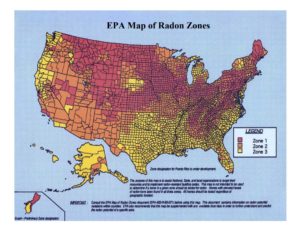
Map courtesy of the U.S. Environmental Protection Agency.
Drunk driving, falls in the home, drownings, and home fires; radon exposure causes more deaths per year than all of those instances, according to the Environmental Protection Agency (EPA).
Radon is the second-largest cause of lung cancer, and though it represents a far smaller risk than cigarette smoking according to the National Cancer Institute, scientists estimate 15,000 to 22,000 lung cancer deaths in the U.S. annually are related to radon.
Washington County Environmental Health Director Jennine Wolf explains how high levels of radon can damage lungs, “Radon decays quickly giving off tiny radioactive particles and when they’re inhaled those radioactive particles can damage the cells in the lining of the lung. So long term exposure damages the lining of the lung, so that’s how lung cancer can get into a nonsmoker.”
EPA recommends that the radon level in a home doesn’t exceed four picocuries per liter. Wolf recommends that homes be tested for radon about every three years, and when buying or selling a home. She says radon can be a risk for those with or without a basement, and Iowa is known to be in the hot pocket of radon levels in the U.S. November is Lung Cancer Awareness Month, and Wolf stresses that lung cancer can be prevented if homeowners monitor their radon levels.

